Linden D., Reddy T.B. (eds.) Handbook of batteries
Подождите немного. Документ загружается.

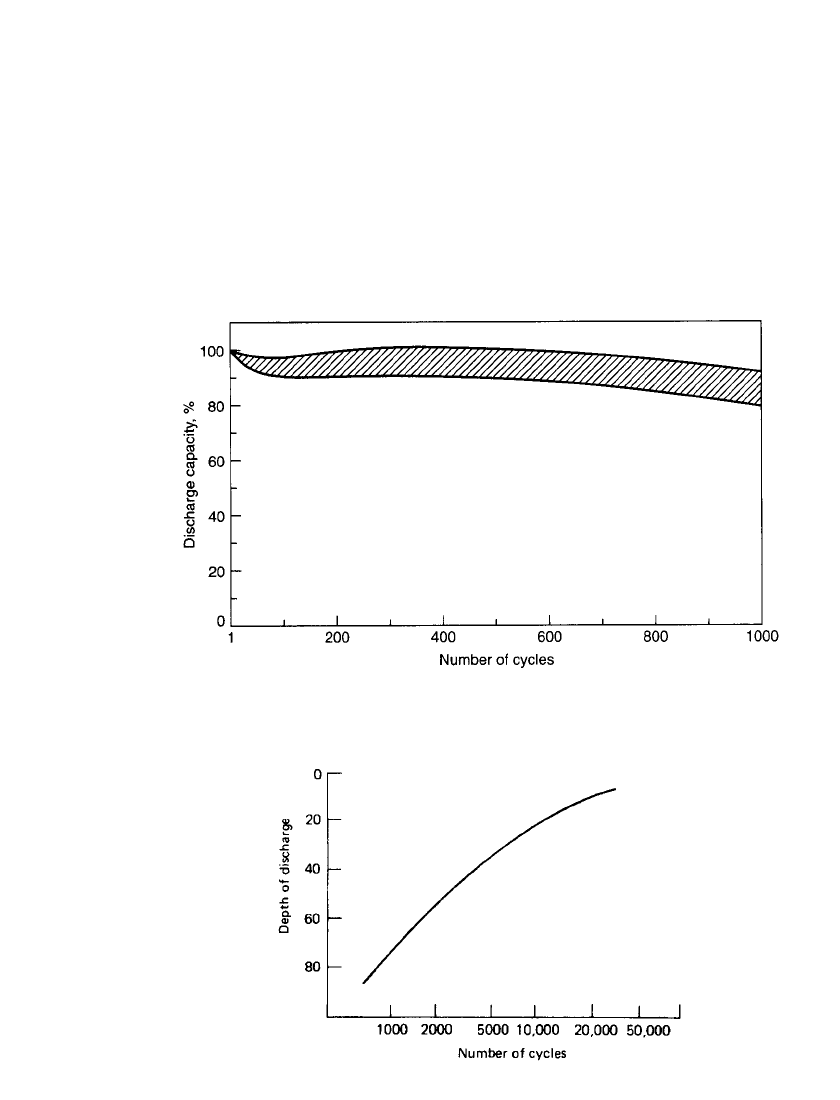
PORTABLE SEALED NICKEL-CADMIUM BATTERIES 28.17
28.4.10 Cycle Life
The cycle life is usually measured to the point when the battery will not deliver more than
a given percentage (usually 60 to 80%) of its rated capacity. Sealed nickel-cadmium batteries
have long cycle lives. Under controlled conditions over 500 cycles can be expected on a full
discharge, as illustrated in Fig. 28.21. On shallow discharges considerably higher cycle life
can be obtained, as shown in Fig. 28.22. Cycle life is also very dependent on the many
conditions to which the battery has been exposed, including charge, overcharge, and dis-
charge rates, frequency of cycling, the temperatures to which the battery has been exposed,
and battery age, as well as battery design and battery components. Specially designed bat-
teries, such as those using alkali-resistant materials, are also manufactured, which have longer
life, particularly at the higher temperatures (see Sec. 28.6).
FIGURE 28.21 Cycle life of sealed nickel-cadmium batteries at 20⬚C. Cycle conditions:
charge—0.1C ⫻ 11 h: discharge—0.7C ⫻ 1 h. Capacity-measuring conditions: charge—
0.1C ⫻ 16 h; discharge—0.2C, end voltage—1 V.
FIGURE 28.22 Cycle life of sealed nickel-cadmium batter-
ies at shallow discharge.
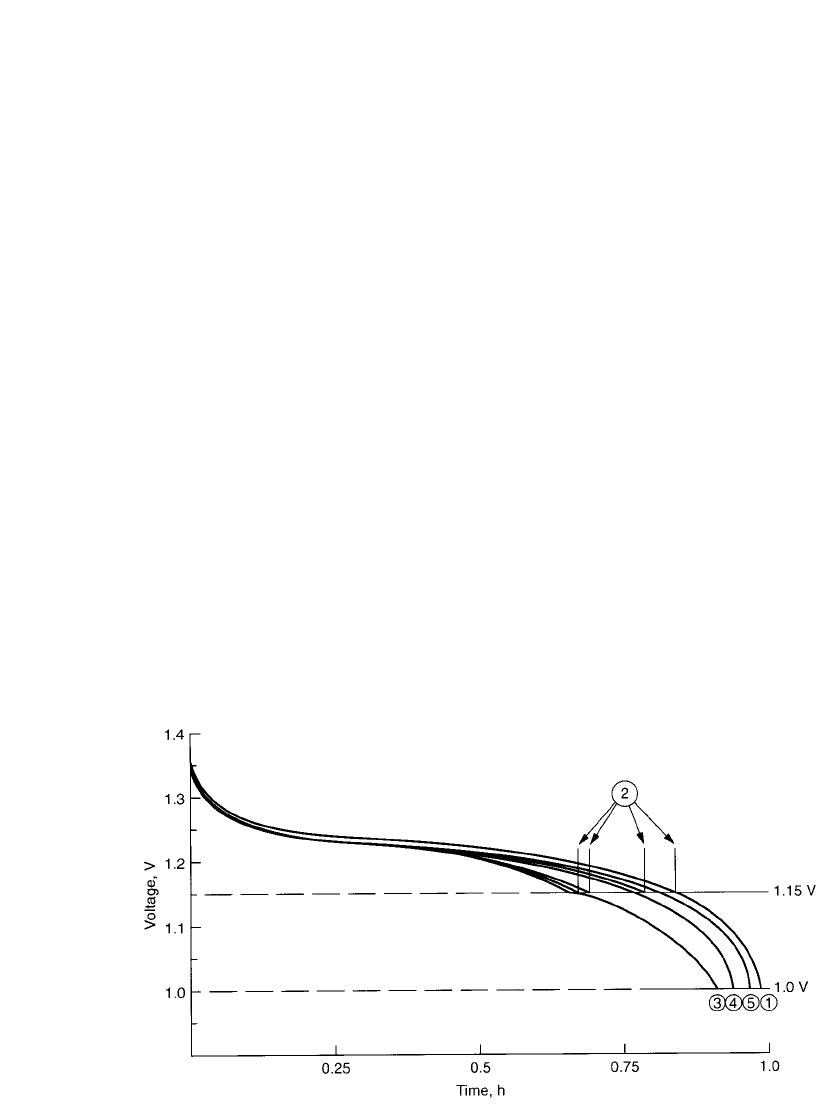
28.18 CHAPTER TWENTY-EIGHT
28.4.11 Life Expectancy and Failure Mechanisms
The useful life of a nickel-cadmium battery can be measured either in terms of the number
of cycles before failure or in units of time. It is virtually impossible to know all the detailed
information necessary to make any kind of accurate prediction of battery life in a given
application. The best that can be provided is an estimate based on laboratory test data and
field experience or extrapolation of accelerated test data.
Basically, failure of a battery occurs when it ceases to operate the device, for whatever
reason, at the prescribed performance level, despite the possibility that the battery may still
be useful in another application with less demanding requirements.
Failure of a nickel-cadmium battery can be classified into two general categories: revers-
ible and irreversible failure. When a battery fails to meet the specified performance require-
ments but can, by appropriate reconditioning, be brought back to an acceptable condition, it
is considered to have suffered a reversible failure. Permanent or irreversible failure occurs
when the battery cannot be returned to an acceptable performance level by reconditioning
or any other means.
Reversible Failures
Voltage Depression (Memory Effect). A sealed nickel-cadmium battery may suffer a
reversible loss of capacity when it is cycled repetitively on shallow discharges (discharge
terminated before its full capacity is delivered) and recharged. For example, as shown in
Fig. 28.23, if a battery is cycled repetitively, but only partially discharged and then recharged,
the voltage and delivered capacity will gradually decrease with cycling (curves 2 representing
repetitive cycling). If the battery is then fully discharged (curve 3), the discharge voltage is
depressed compared to the original full discharge (curve 1). The discharge profile may show
two steps and the battery may not deliver the full capacity to the original cutoff voltage.
This phenomenon is known as ‘‘voltage depression.’’ It also is referred to as ‘‘memory
effect,’’ as the battery appears to ‘‘remember’’ the lower capacity of the shallow discharge.
Operation at higher temperatures accelerates this type of loss.
The battery can be restored to full capacity with a few full discharge-charge reconditioning
cycles. The discharge characteristics on the reconditioning cycles are illustrated in Fig. 28.23
(curves 4 and 5).
FIGURE 28.23 Voltage depression and subsequent recovery.
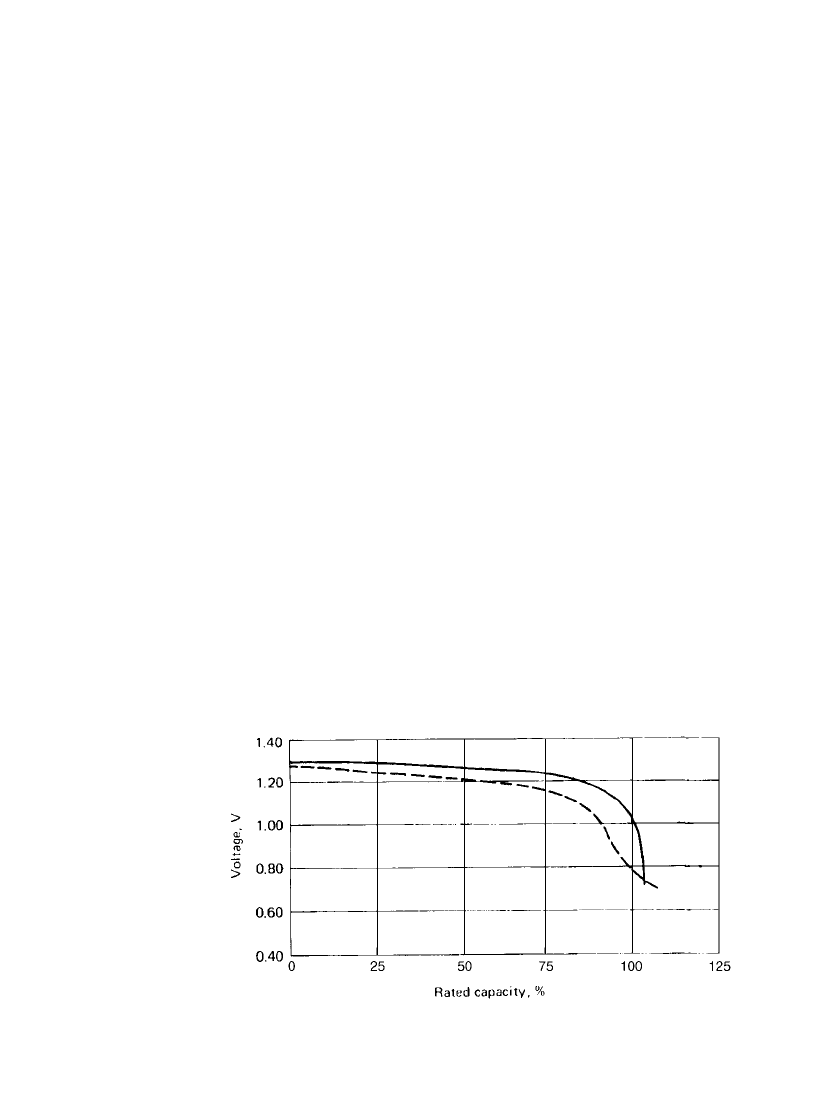
PORTABLE SEALED NICKEL-CADMIUM BATTERIES 28.19
The voltage drop occurs because only a portion of the active materials is discharged and
recharged during shallow or partial discharging. The active materials that have not been
cycled, particularly the cadmium electrode, may undergo a change in physical characteristics
and an increase in resistance. The effect has also been ascribed to structural changes in the
nickel electrode.
1
Subsequent cycling restores the active materials to their original state.
The extent of voltage depression depends on the depth of discharge and can be avoided
or minimized by the selection of an appropriate end voltage. Too high an end voltage, such
as 1.16 V per cell, terminates the discharge prematurely. (A high end voltage should be used
only if an extended cycle life is desired and the lower capacity can be tolerated, as in some
satellite applications.) A small voltage depression may be observed if the discharge is ter-
minated between 1.16 and 1.10 V per cell. The extent of the depression is dependent on the
depth of discharge, which is also rate-dependent. Discharging to an end voltage below 1.1 V
per cell should not result in a subsequent voltage depression. Discharging to too low an end
voltage, however, should be avoided, as discussed in Sec. 28.4.6.
This phenomenon varies with the design and formulation of the electrode and may not
be evident with all sealed nickel-cadmium batteries. Modern nickel-cadmium batteries use
electrode structures and formation processes that reduce the susceptibility to voltage depres-
sion, and most users may never experience low performance due to memory effect. However,
the use of the term ‘‘memory effect’’ persists, since it is often used to explain low battery
capacity that is attributable to other problems, such as ineffective charging, overcharge,
battery aging, or exposure to high temperatures.
Overcharging. A similar reversible failure can occur with long-term overcharging, par-
ticularly at elevated temperatures. Figure 28.24 shows the voltage ‘‘step’’ near the end of
discharge that can be induced by long-term overcharging. The capacity is still available, but
at a lower voltage than when it was freshly cycled. Again, this is a reversible failure; a few
charge and discharge cycles will restore normal voltage and expected capacity.
FIGURE 28.24 Typical discharge voltage profile of sealed nickel-cadmium
batteries after long-term overcharge (dotted line) vs. 16-h charge, both at C
/ 10 rate.

28.20 CHAPTER TWENTY-EIGHT
Irreversible Failures. Permanent failure in nickel-cadmium batteries results from essen-
tially two causes: short-circuiting and loss of electrolyte. An internal short circuit may be of
relatively high resistance and will be evidenced by an abnormally low on-charge voltage and
by a drop of voltage as the battery’s energy is dissipated through the internal short circuit.
A short circuit may also be of such a low resistance that virtually all the charge current
travels through it or the battery electrodes are totally shorted internally.
Any loss of electrolyte will cause degradation in capacity. Charging at high rates, repeated
voltage reversal, and direct short-circuiting are ways that can cause loss of electrolyte through
the pressure relief device. Electrolyte can also be lost over a long period of time through
the battery seals, and capacity is lost in proportion to the reduction in electrolyte volume.
Capacity degradation caused by electrolyte losses is more pronounced at high discharge rates.
High temperature degrades battery performance and life. A nickel-cadmium battery gives
optimum performance and life at temperatures between 18 and 30
⬚C. Higher temperatures
reduce life by promoting separator deterioration and increasing the probability of short-
circuiting. Higher temperatures also cause more rapid evaporation of moisture through the
seals. These effects are all long-term; but the higher the temperature, the more rapid the
deterioration. Table 28.2 lists the recommended temperature limits for sealed nickel-cadmium
batteries.
TABLE 28.2 Operating and Storage Limits for
Sealed Nickel-Cadmium Batteries
Type
Temperature,
⬚C
Storage Operating
Button ⫺40 to 50 ⫺20 to 50
Standard cylindrical
⫺40 to 50 ⫺40 to 70
Premium cylindrical
⫺40 to 70 ⫺40 to 70
28.5 CHARGING CHARACTERISTICS
28.5.1 General Characteristics
Sealed nickel-cadmium batteries are usually charged by means of the constant-current
method. The 0.1C rate can be used and the battery is charged for 12 to 16 h (140%). At
this rate the battery can withstand overcharging without harm, although most sealed nickel-
cadmium batteries can be safely charged at the C /100 to C/ 3 rate. At higher charge rates
care must be taken not to overcharge the battery excessively or develop high battery tem-
peratures.
The voltage profile of a sealed nickel-cadmium battery during charge at the C /10 and
C/ 3 rates is shown in Fig. 28.25. A sharp rise in voltage to a peak near the end of the charge
is evident.
The voltage profile of a sealed nickel-cadmium batteries is different from the one for a
vented one, as illustrated in Fig. 28.26 The end-of-charge voltage for the sealed battery is
lower. The negative plate does not reach as high a state of charge as it does in the vented
construction because of the oxygen recombination reaction.
Constant-potential charging is not recommended for sealed nickel-cadmium batteries as
it can lead to thermal runaway. It can, however, be used if precautions are taken to limit the
current toward the end of charge.
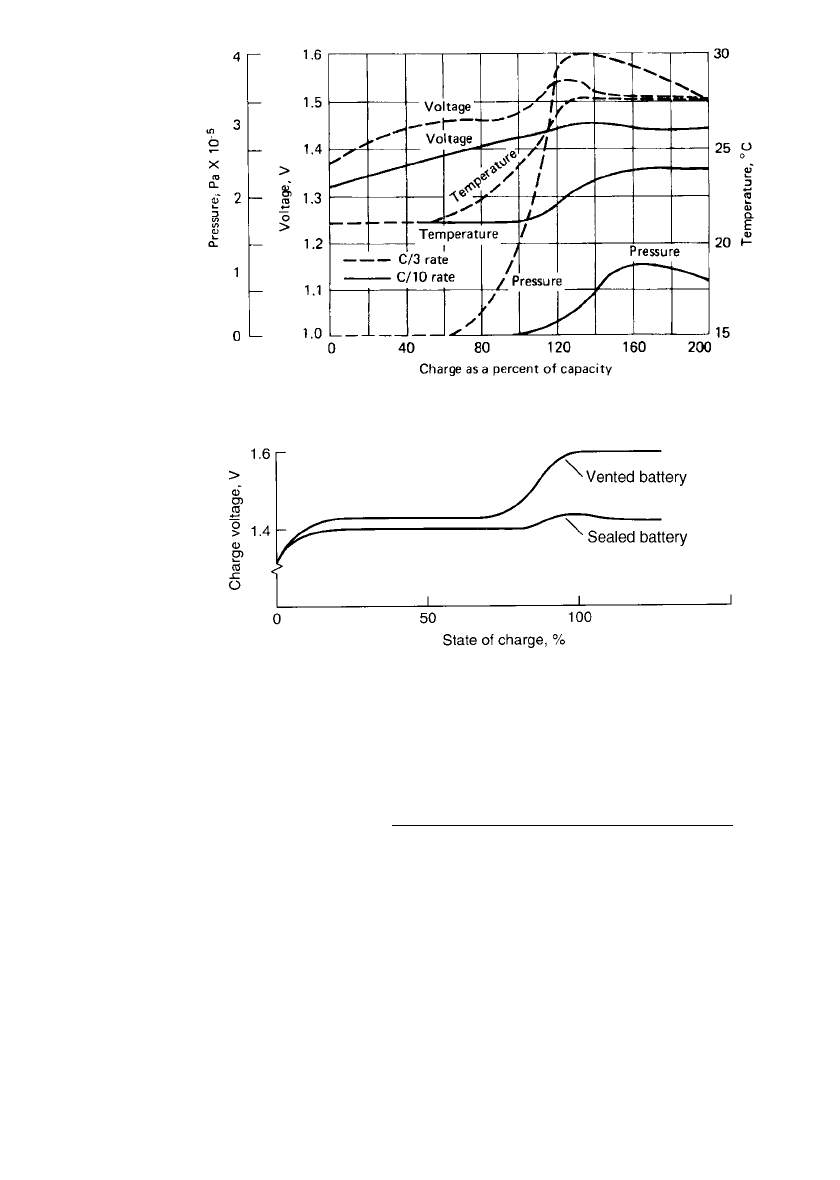
PORTABLE SEALED NICKEL-CADMIUM BATTERIES 28.21
FIGURE 28.25 Typical pressure, temperature, and voltage relationships of sealed
nickel-cadmium battery during charge.
FIGURE 28.26 Charge vs. voltage for sealed and vented nickel-cadmium
batteries at 25⬚C; 0.1C charge rate.
28.5.2 The Charge Process
The charge process is summarized in Fig. 28.27. Figure 28.27a plots the charge efficiency,
discharge energy (on subsequent discharge)
Charge efficiency ⫽
charge input energy
against total input energy. At the start of the discharge (area 1), the charge energy is con-
sumed by the conversion of the active materials into a chargeable form, and the charge
efficiency is low. In area 2 charging is most efficient and almost all of the input energy is
used to convert the discharged active material into the charged state. As the battery ap-
proaches the charge state (area 3), most of the energy goes to the generation of oxygen, and
the charge efficiency is low.
Figure 28.27b presents the relationship of charge efficiency to charge rate. It shows that
the charge efficiency, as well as the output capacity, is lower at a lower charge rate.
The charge efficiency also depends on the ambient temperature during charge. This re-
lationship is shown in Fig. 28.27c. There is a decrease in capacity in the high-temperature
range due to a fall in potential for oxygen gas generation at the positive electrode.
The principle of the sealed battery is based on the ability of the negative electrode to
recombine this oxygen gas and prevent the buildup of internal gas pressure. The capacity
for this recombination is limited. Hence the maximum charge rate that can be tolerated is
the one that keeps the rate of oxygen generation below the gas recombination rate so that
the internal gas pressure does not build up excessively.
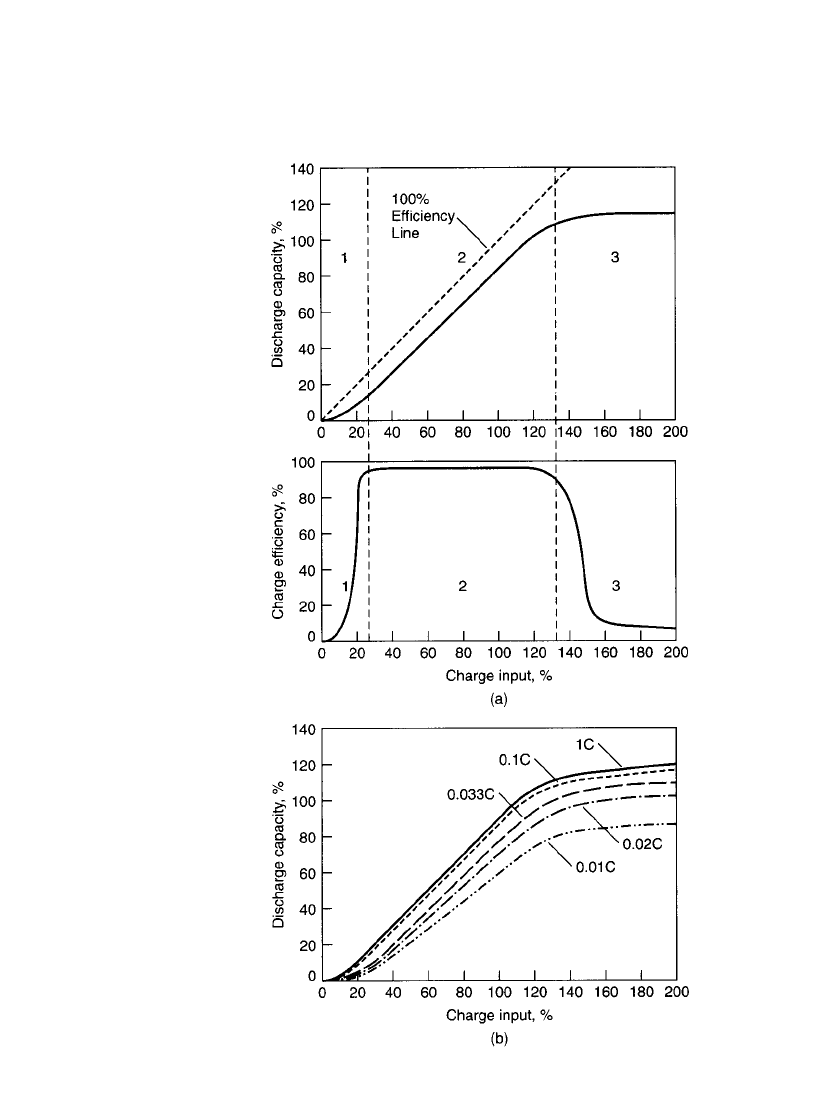
28.22 CHAPTER TWENTY-EIGHT
Overcharging, at rates beyond the ability of oxygen recombination or heat dissipation,
can result in failure. ‘‘Fast’’ charging methods can be used successfully, but a means must
be provided for monitoring and terminating the charge before excessive overcharging occurs.
Temperature rise, voltage, or pressure can be monitored and used effectively as a cutoff.
FIGURE 28.27 Charge process of sealed nickel-cadmium bat-
teries. (a) Charge efficiency at 20⬚C. Charge—0.1C ⫻ 16 h;
discharge—0.2⬚C; end voltage—1 V. (b) Charge efficiency vs.
charge rate at 20⬚C.
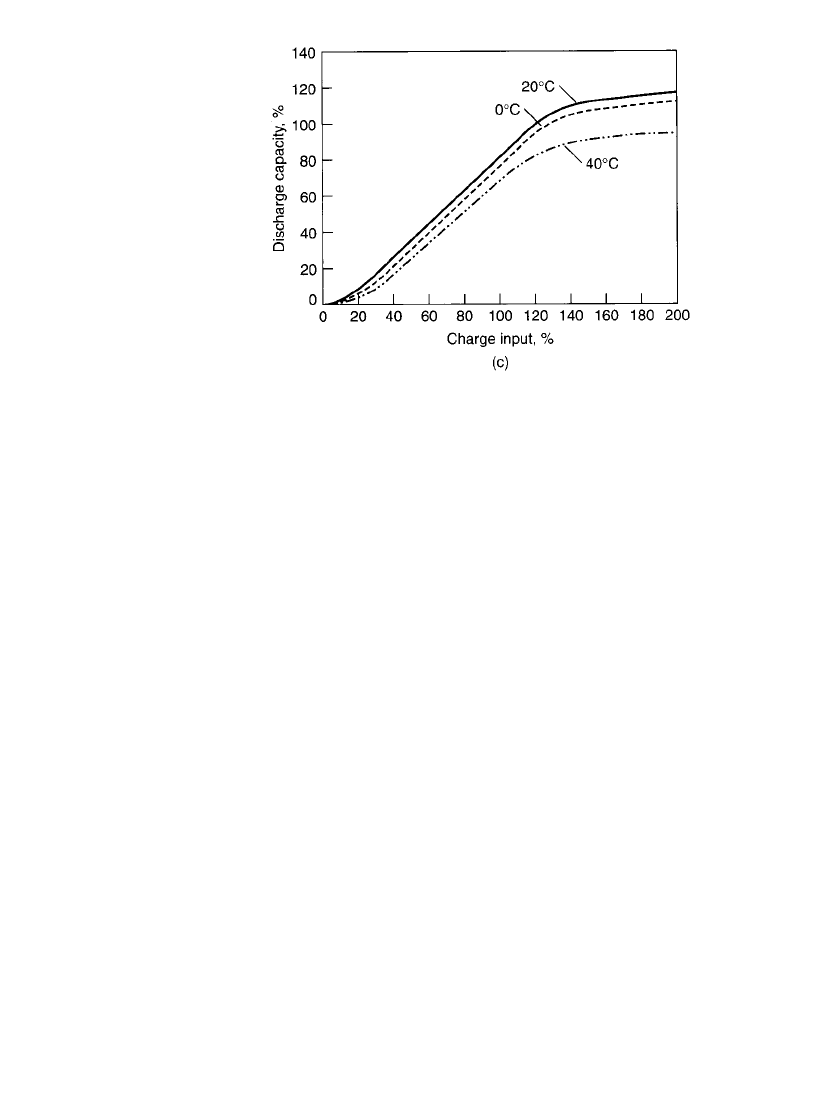
PORTABLE SEALED NICKEL-CADMIUM BATTERIES 28.23
FIGURE 28.27 (c) Charge efficiency vs. ambient temperature
during charge at 0.1C rate (Continued ).
28.5.3 Voltage, Temperature, and Pressure Relationships
Figure 28.25 also shows the relationship of voltage, temperature, and pressure of a typical
sealed battery during charging at the C /10 and C /3 rates. The voltage increases gradually
during the charge until the battery is about 75 to 80% charged. The voltage then rises more
sharply due to the generation of oxygen at the positive electrode. The temperature remains
relatively constant during the early part of the charge as the charge reaction is endothermic.
It then rises as the battery reaches the overcharge state due to the heat generated by the
oxygen recombination reaction. Similarly the internal pressure remains low until the battery
goes into the overcharge condition, when most of the current is used to produce oxygen and
the pressure rises. Finally, as the battery reaches full charge, the voltage drops because of a
decrease in the battery’s internal resistance due to the increase in the battery temperature.
This drop in voltage can be used effectively in a control circuit to terminate the charge.
As shown, when the battery is overcharged at acceptable rates, the pressure and temper-
ature tend to stabilize. These steady-state conditions are governed by such factors as ambient
temperature, overcharge rate, heat transfer characteristics of the cell and battery, cell design
and components such as the separator, recombination capability of the negative electrode,
and the resistance of the cell and battery. Charging at higher rates, such as the C /3 rate
compared to the C/ 10 rate, results in higher temperatures and internal pressures. At higher
charge rates, temperature and pressure will rise more significantly, particularly if the oxygen
recombination rate is exceeded. Because of the possibility of venting and other deleterious
effects on battery performance due to these high temperatures and pressures, it is necessary
to terminate the charge before these conditions are reached.
28.5.4 Voltage Characteristics during Charge
The voltage profile of a sealed nickel-cadmium battery during charge at various charge rates
at 20
⬚C is shown in Fig. 28.28. The charge voltage also depends on temperature, as shown
in Fig. 28.29. The voltage and voltage peak decrease with a rise in temperature. Charging
at temperatures between 0 and 30
⬚C is best for sealed batteries. At lower temperatures the
voltage increases, recombination of oxygen is slower, and the internal gas pressure tends to
increase. Charging rates must be reduced. Above 40
⬚C the charging efficiency is low, and
higher temperatures cause battery deterioration.
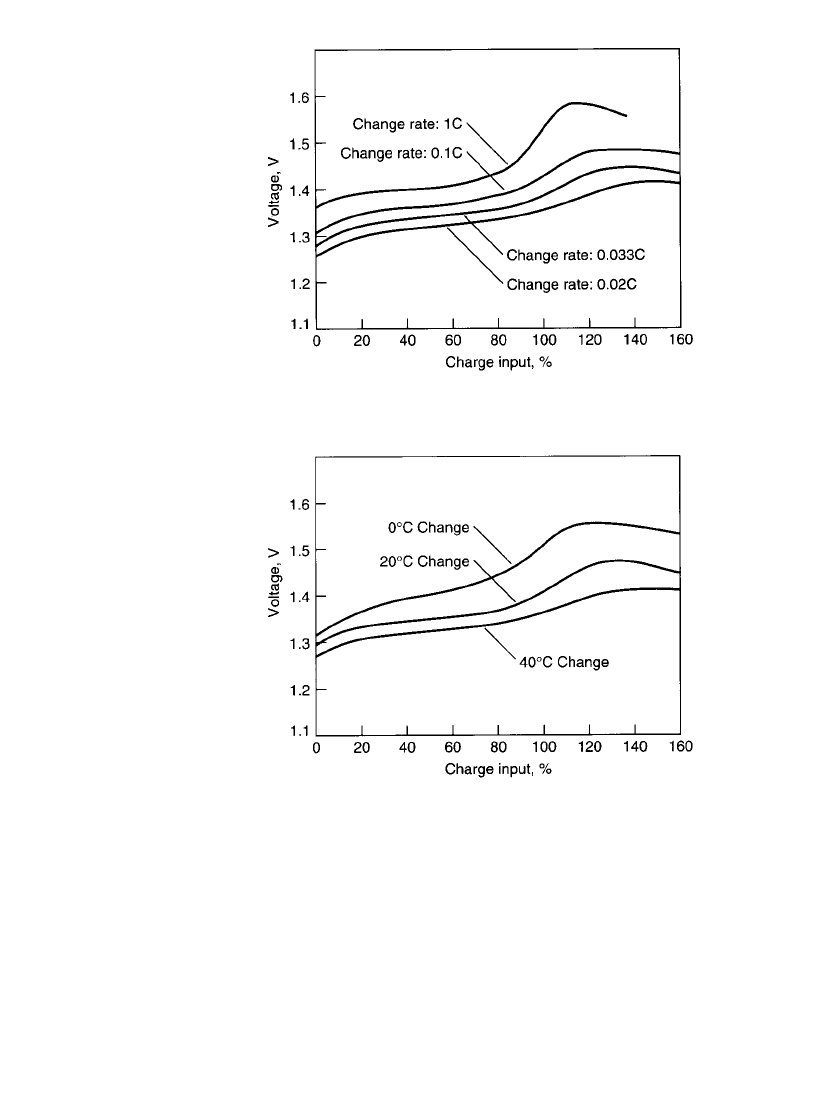
28.24 CHAPTER TWENTY-EIGHT
FIGURE 28.28 Voltage profile during charge at various charge
rates at 20⬚C.
FIGURE 28.29 Voltage profile during charge at 0.1C rate at
various temperatures.
28.5.5 Charge Methods
There are a number of different methods for charging sealed nickel-cadmium batteries. The
standard method is a quasi-constant current charge at a relatively low rate. ‘‘Fast’’ charge
methods are becoming more popular in order to reduce the time required for charging. A
control circuit is needed when charging at these high rates to cut off the charge or reduce
the charge current at the completion of charge. Figure 28.30 shows the voltage and current
profiles during charge for each of the charge control methods. (Also see Sec. 5.5.)
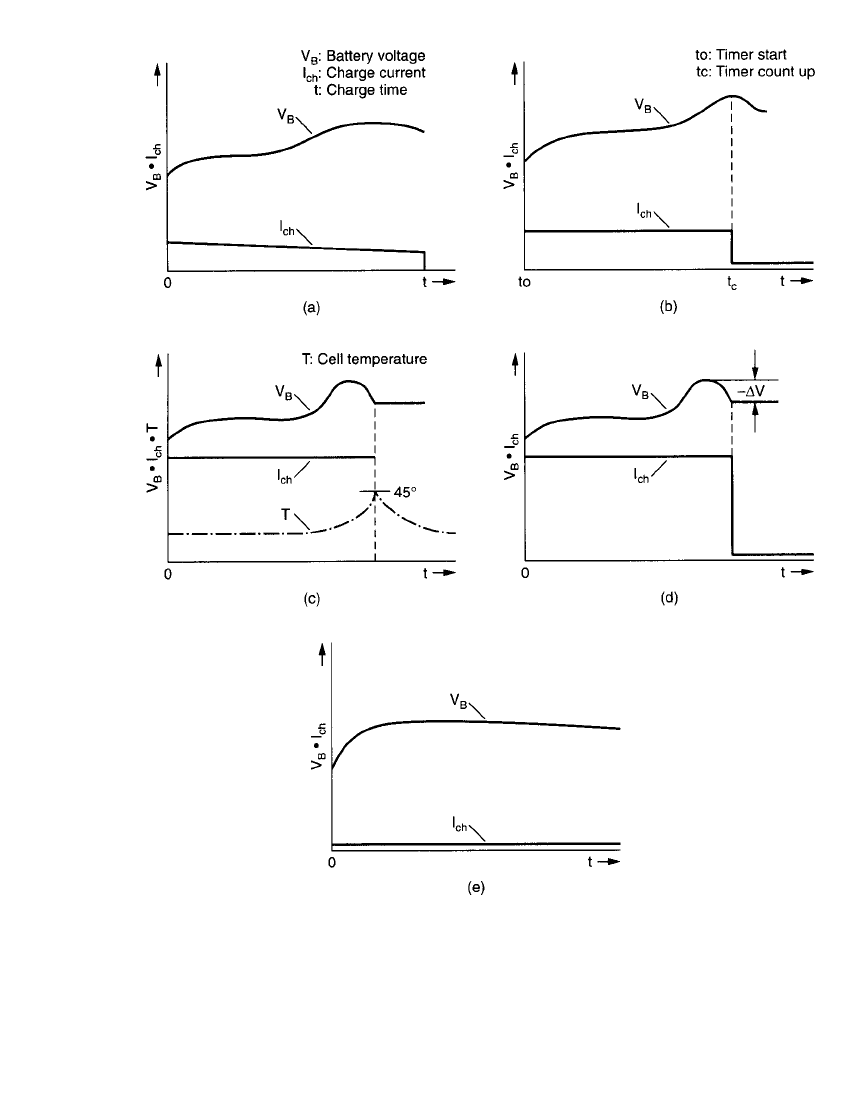
PORTABLE SEALED NICKEL-CADMIUM BATTERIES 28.25
FIGURE 28.30 Methods for charging sealed nickel-cadmium batteries and charge control. (a) Sem-
iconstant current (V
B
—battery voltage; I
ch
—charge current; t—time). (b) Timer control ( t
0
—timer start;
t
c
—timer count up). (c) Temperature detection ( T—battery temperature). (d ) ⫺⌬V detection. (e) Trickle
charge. (Courtesy of Panasonic Industrial Co., Division of Matsushita Electric Corp. of America.)
Standard Method. (Fig. 28.30a). This is the simplest method, which uses a relatively in-
expensive circuit, controlling the charge current by inserting a resistance between the DC
power supply and the battery. The battery is charged at a constant current at a low (C/10)
rate so that the generation of oxygen is below the recombination rate. This rate also limits
the temperature rise. Excessive overcharge should be avoided. The battery should be charged
to about 140 to 150% charge input.

28.26 CHAPTER TWENTY-EIGHT
Timer Control. (Fig. 28.30b). For moderate charge rates a timer can be used to cut off the
charge or reduce the charge current to the trickle charge level. This is a relatively inexpensive
control device and suitable for applications where the battery is usually fully discharged
before charging. It is not suitable for applications where the battery is frequently charged
without prior deep discharging as this could result in excessive overcharge. A thermal cutoff
control should be used when charging at rates higher than the C /5 rate or without deep
discharging to prevent the battery from reaching high temperatures.
Temperature Detection. (Fig. 28.30c). This control system uses a sensor to detect the
temperature rise of the battery and terminate the charge. A thermostat or thermistor is used
as the detection device, and the detecting temperature is usually set at 45
⬚C. It is important
that the sensor be located so that it can accurately determine the battery’s temperature.
Charging in high ambient temperatures can result in an insufficient charge while low ambient
temperatures may result in overcharge. The cycle life with this method may be shorter than
with the
⫺⌬V method or peak voltage methods as the battery could be subjected to more
overcharge.
Negative Delta V (⫺⌬V ). (Fig. 28.30d ). This is one of the preferred charge control systems
for sealed nickel-cadmium batteries. The drop in voltage of the battery is detected after the
battery voltage has reached its peak during charge. The signal can be used to terminate the
charge or reduce the charge current to a trickle charge. The method provides a complete
charge regardless of ambient temperature or residual capacity from the previous charge. A
value of 10 to 20 mV per cell is usually used for the control. The method is not suitable
for charging below the 0.5C as the
⫺⌬V value is too low to be detectable.
Trickle and Float Charge. (Fig. 28.30e). Trickle charge systems are used in two different
situations (1) in a standby power application where the battery is on continual charge to
maintain it in a state of full charge (compensating for self-discharge) until it is connected to
the load when the prime power fails, and (2) as a supplementary charge after the termination
of rapid charging. Charging is at the 0.02 to 0.05C rate, depending on the frequency and
depth of discharge. A periodic discharge every six months followed by a charge is advisable
to ensure optimum performance.
28.6 SPECIAL-PURPOSE BATTERIES
Special-purpose sealed nickel-cadmium batteries are manufactured with specifically designed
characteristics, overcoming some of the limitations of standard batteries, to meet the require-
ments for certain applications. Manufacturers’ recommendations should be followed because
of the specific performance characteristics of these batteries.
28.6.1 High-Capacity Batteries
These batteries incorporate design features, such as nickel foam substrate positive plates,
pasted negative electrodes, thin-walled battery containers, and increased amounts of active
material. These changes result in a 20 to 40% increase in capacity. These batteries are also
designed with improved oxygen recombination capability and are capable of being charged
at the 0.2C rate or less without control. They are capable of fast 1-h charging using
⫺⌬V
charge control. Figure 28.31 compares the discharge characteristics of the high-capacity
battery with those of a standard battery. Figure 28.32 shows the relationship of battery
capacity and discharge current for the two designs.
